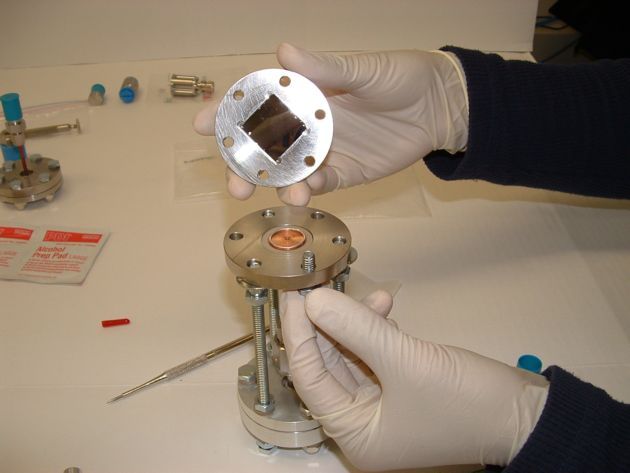Announcement
Collapse
No announcement yet.
Nuclear batteries....
Collapse
X
-
-
Those plutonium batteries have been around for quite some time now. Others also used strontium 90 and other isotopes.
The danger from a nuclear battery is very low. The casing is very tough and the radiation is alpha & beta, meaning it has trouble passing through paper and aluminum foil respectively.
Anyone remember the Superman character Metallo (aka: John Corben)? Seems he had a Kryptonite powered heart.
Dr. MordridLast edited by Dr Mordrid; 14 May 2005, 08:16.Dr. Mordrid
----------------------------
An elephant is a mouse built to government specifications.
I carry a gun because I can't throw a rock 1,250 fps
Comment
-
This is typical of the emotive response to the word 'radioactive' by the ignorant.Originally posted by KvHagedornI know.. one of its stated uses is in pacemakers. Would you put a source of radioactivity inside your chest cavity?
1. The radiation from tritium is totally harmless when the gas is contained. It would not even pass through a sheet of paper or any human tissue, let alone a titanium pacemaker box.
2. Pacemakers are not put in the chest cavity, they are placed just under the skin below the collar bone.
3. Even if there were a risk, which there isn't, would that not be preferable to a rapid mortality from a total cardiac AV block?
4. Even if there were a risk of a radiation leakage, the hormesis from such a low ionising radiation level would reduce the risk of cancer or any other harmful effect.
5. If such a battery could keep a pacemaker going for 12 years, instead of the current 8 years (average) with a Lithium-ion battery, the advantage is significant, because the procedure of replacement is not over-pleasant (surgery under local anaesthetic - 3 days hospitalisation).
6. With these criteria to modify your question into something sensible, the answer is a most resounding YES, I would have it done. And, just in case you think this is theoretical, my second pacemaker is ending its life in about 12 - 18 months.
Request: please don't jump to conclusions.Brian (the devil incarnate)
Comment
-
I think it would be KEWL to have a radioactive heart.


And yes, I would love to have one of these oldtype batteries. I woulndt call the content of "less than 3 curries" a LOW content - since its afaik rather high - but being incased strongly enough to withstand incineration - I think it would outlast any damage done to me.
~~DukeP~~
Comment
-
Originally posted by DukePI think it would be KEWL to have a radioactive heart.


And yes, I would love to have one of these oldtype batteries. I woulndt call the content of "less than 3 curries" a LOW content - since its afaik rather high - but being incased strongly enough to withstand incineration - I think it would outlast any damage done to me.
~~DukeP~~
Even the casing would do
Comment
-
Does the pacemaker send the electronic impulse from the chest or are there actually wires attached to the heart?Originally posted by Brian Ellis
2. Pacemakers are not put in the chest cavity, they are placed just under the skin below the collar bone.
Comment
-
The pacemaker is about the size of a US silver dollar.
When implanted it's placed under the skin about 1" (2.5 cm) below the collarbone, then the wire (or wires; there can be 1 or 2) is threaded into the subclavian vein (it's right under the collarbone). From there it can be maneuvered into the proper chamber of the heart under fluoroscopic control.
There are also temporary pacemakers that can be used while the patient is treated in the hospital then removed or they can be replaced with a permanent one if necessary. Temporary pacemaker electrodes are most often threaded through a vein in the neck.
Once in the proper chamber the electrode at the end of the wire(s) is positioned so it touches the chamber wall. Once in contact the pacemaker can deliver programmed pulses to the heart to stimulate proper beating.
There are several types of pacemakers;
Fixed rate pacemakers give off electrical impulses at a steady, regular rate, regardless of the level of activity.
Rate responsive pacemakers change the rate of electrical impulses as the activity level changes.
Single chamber pacemakers control only the ventricle (lower chamber).
Dual chamber pacemakers control both the atrium (upper chamber) and ventricle.
Often a pacemaker is set to deliver pulses only when the heart rate falls below a predetermined level. This is called demand mode.
Other implantable cardiac devices include a small defibrillator (aka: cardioverter) for use in patients that often throw dangerous beat patterns. When such beats are detected a jolt is delivered to re-stabilize the heart.
Pacemakers can be programmed and diagnosed from the outside using a small device that is placed on the skin over the pacemaker.
Dr. MordridLast edited by Dr Mordrid; 14 May 2005, 20:24.Dr. Mordrid
----------------------------
An elephant is a mouse built to government specifications.
I carry a gun because I can't throw a rock 1,250 fps
Comment







Comment